Abstract
Proline is established as a potent breaker of both alpha-helical and beta-sheet structures in soluble (globular) proteins. Thus, the frequent occurrence of the Pro residue in the putative transmembrane helices of integral membrane proteins, particularly transport proteins, presents a structural dilemma. We propose that this phenomenon results from the fact that the structural propensity of a given amino acid may be altered to conform to changes imposed by molecular environment. To test this hypothesis on proline, we synthesized model peptides of generic sequence H2N-(Ser-LyS)2-Ala- Leu-Z-Ala-Leu-Z-Trp-Ala-Leu-Z-(Lys-Ser)3-OH (Z = Ala and/or Pro). Peptide conformations were analyzed by circular dichroism spectroscopy in aqueous buffer, SDS, lysophosphatidylglycerol micelles, and organic solvents (methanol, trifluoroethanol, and 2-propanol). The helical propensity of Pro was found to be greatly enhanced in the membrane-mimetic environments of both lipid micelles and organic solvents. Proline was found to stabilize the alpha-helical conformation relative to Ala at elevated temperatures in 2-propanol, an observation that argues against the doctrine that Pro is the most potent alpha-helix breaker as established in aqueous media. Parallel studies in deoxycholate micelles of the temperature-induced conformational transitions of the single-spanning membrane bacteriophage IKe major coat protein, in which the Pro-containing wild type was compared with Pro30 --> Ala mutant, Pro was found to protect the helix, but disrupt the beta-sheet structure as effectively as it does to model peptides in water. The intrinsic capacity of Pro to disrupt beta-sheets was further reflected in a survey of porins where Pro was found to be selectively excluded from the core of membrane-spanning beta-sheet barrels. The overall data provide a rationale for predicting and understanding the structural consequences when Pro occurs in the context of a membrane.
Full text
PDF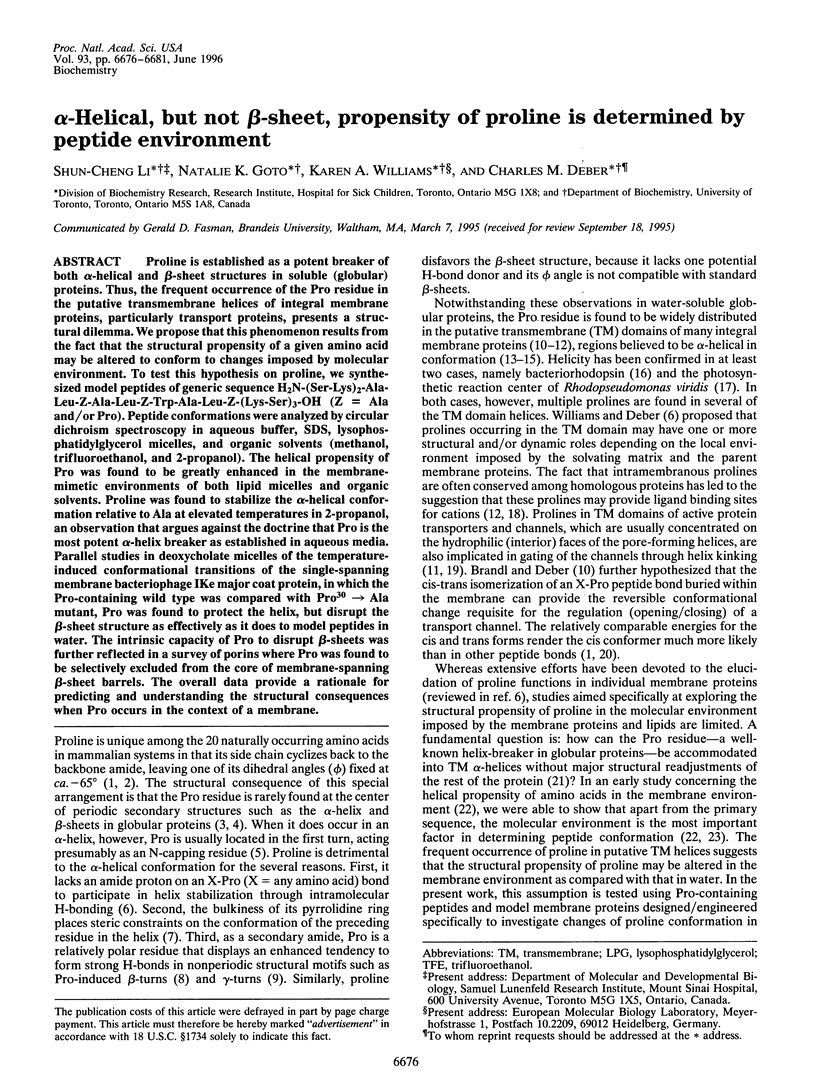

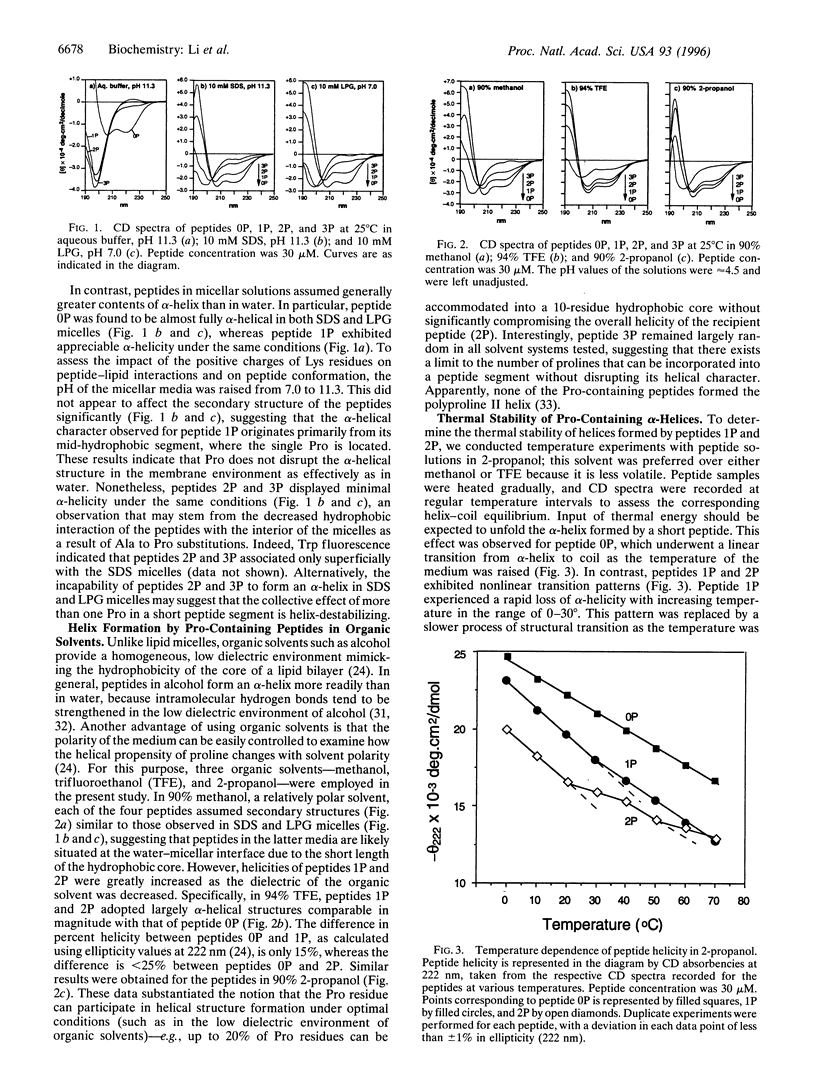
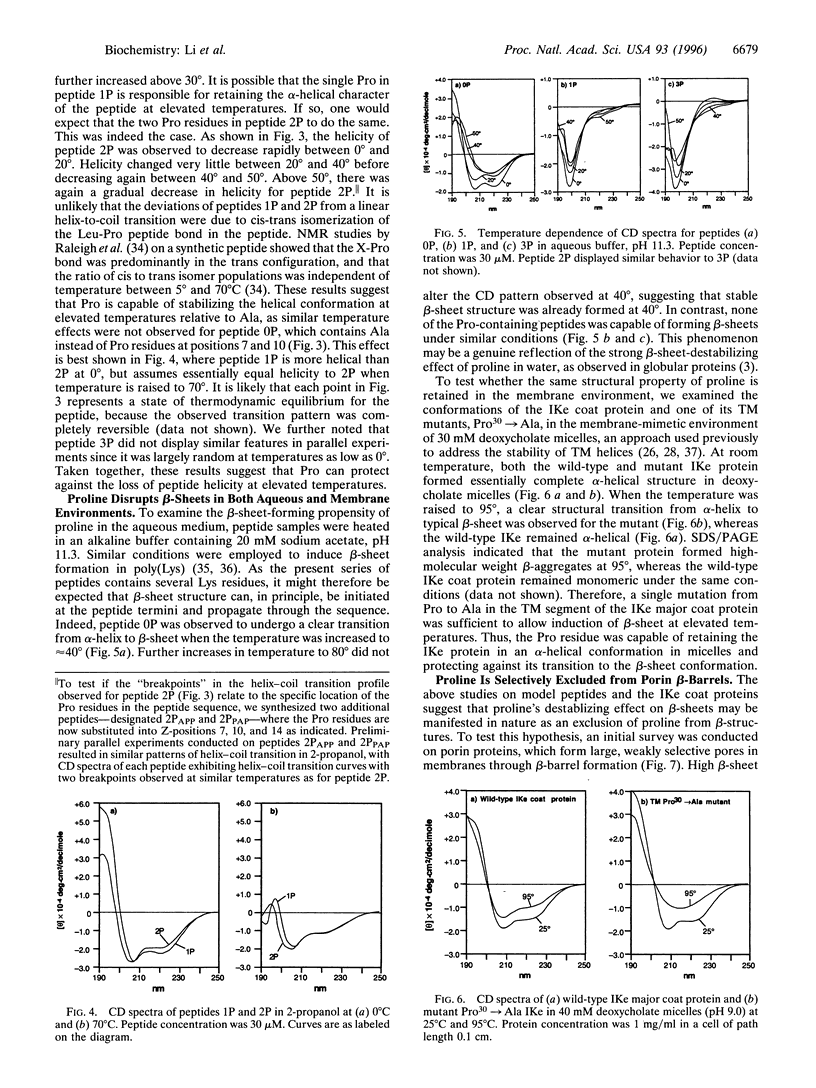
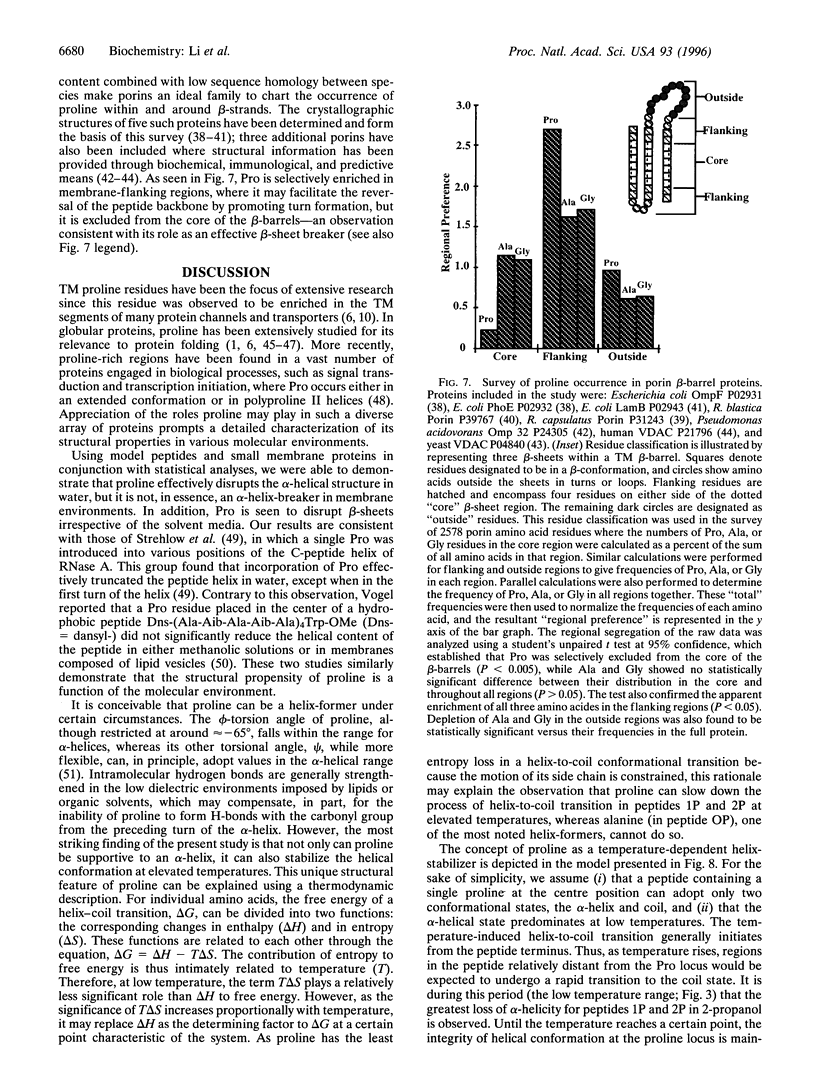
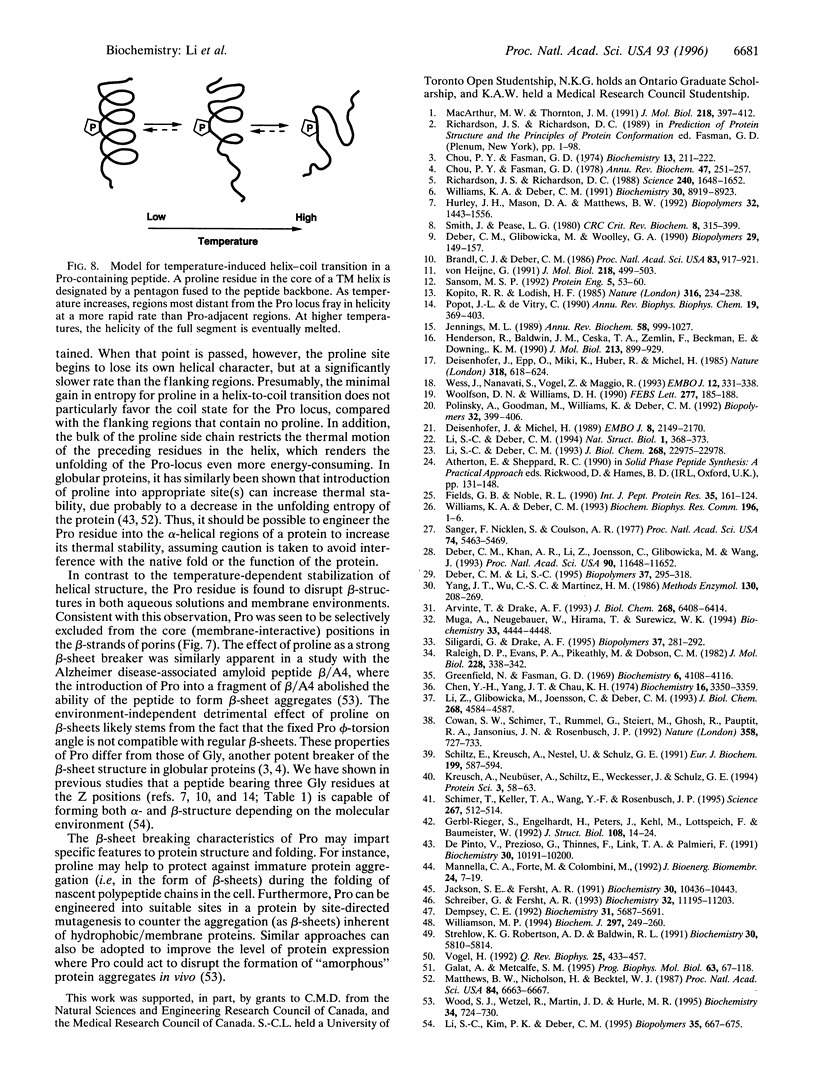
Selected References
These references are in PubMed. This may not be the complete list of references from this article.
- Arvinte T., Drake A. F. Comparative study of human and salmon calcitonin secondary structure in solutions with low dielectric constants. J Biol Chem. 1993 Mar 25;268(9):6408–6414. [PubMed] [Google Scholar]
- Brandl C. J., Deber C. M. Hypothesis about the function of membrane-buried proline residues in transport proteins. Proc Natl Acad Sci U S A. 1986 Feb;83(4):917–921. doi: 10.1073/pnas.83.4.917. [DOI] [PMC free article] [PubMed] [Google Scholar]
- Chen Y. H., Yang J. T., Chau K. H. Determination of the helix and beta form of proteins in aqueous solution by circular dichroism. Biochemistry. 1974 Jul 30;13(16):3350–3359. doi: 10.1021/bi00713a027. [DOI] [PubMed] [Google Scholar]
- Chou P. Y., Fasman G. D. Conformational parameters for amino acids in helical, beta-sheet, and random coil regions calculated from proteins. Biochemistry. 1974 Jan 15;13(2):211–222. doi: 10.1021/bi00699a001. [DOI] [PubMed] [Google Scholar]
- Chou P. Y., Fasman G. D. Empirical predictions of protein conformation. Annu Rev Biochem. 1978;47:251–276. doi: 10.1146/annurev.bi.47.070178.001343. [DOI] [PubMed] [Google Scholar]
- Cowan S. W., Schirmer T., Rummel G., Steiert M., Ghosh R., Pauptit R. A., Jansonius J. N., Rosenbusch J. P. Crystal structures explain functional properties of two E. coli porins. Nature. 1992 Aug 27;358(6389):727–733. doi: 10.1038/358727a0. [DOI] [PubMed] [Google Scholar]
- De Pinto V., Prezioso G., Thinnes F., Link T. A., Palmieri F. Peptide-specific antibodies and proteases as probes of the transmembrane topology of the bovine heart mitochondrial porin. Biochemistry. 1991 Oct 22;30(42):10191–10200. doi: 10.1021/bi00106a017. [DOI] [PubMed] [Google Scholar]
- Deber C. M., Glibowicka M., Woolley G. A. Conformations of proline residues in membrane environments. Biopolymers. 1990 Jan;29(1):149–157. doi: 10.1002/bip.360290120. [DOI] [PubMed] [Google Scholar]
- Deber C. M., Khan A. R., Li Z., Joensson C., Glibowicka M., Wang J. Val-->Ala mutations selectively alter helix-helix packing in the transmembrane segment of phage M13 coat protein. Proc Natl Acad Sci U S A. 1993 Dec 15;90(24):11648–11652. doi: 10.1073/pnas.90.24.11648. [DOI] [PMC free article] [PubMed] [Google Scholar]
- Deber C. M., Li S. C. Peptides in membranes: helicity and hydrophobicity. Biopolymers. 1995;37(5):295–318. doi: 10.1002/bip.360370503. [DOI] [PubMed] [Google Scholar]
- Deisenhofer J., Michel H. Nobel lecture. The photosynthetic reaction centre from the purple bacterium Rhodopseudomonas viridis. EMBO J. 1989 Aug;8(8):2149–2170. doi: 10.1002/j.1460-2075.1989.tb08338.x. [DOI] [PMC free article] [PubMed] [Google Scholar]
- Fields G. B., Noble R. L. Solid phase peptide synthesis utilizing 9-fluorenylmethoxycarbonyl amino acids. Int J Pept Protein Res. 1990 Mar;35(3):161–214. doi: 10.1111/j.1399-3011.1990.tb00939.x. [DOI] [PubMed] [Google Scholar]
- Galat A., Metcalfe S. M. Peptidylproline cis/trans isomerases. Prog Biophys Mol Biol. 1995;63(1):67–118. doi: 10.1016/0079-6107(94)00009-x. [DOI] [PubMed] [Google Scholar]
- Gerbl-Rieger S., Engelhardt H., Peters J., Kehl M., Lottspeich F., Baumeister W. Topology of the anion-selective porin Omp32 from Comamonas acidovorans. J Struct Biol. 1992 Jan-Feb;108(1):14–24. doi: 10.1016/1047-8477(92)90003-s. [DOI] [PubMed] [Google Scholar]
- Greenfield N., Fasman G. D. Computed circular dichroism spectra for the evaluation of protein conformation. Biochemistry. 1969 Oct;8(10):4108–4116. doi: 10.1021/bi00838a031. [DOI] [PubMed] [Google Scholar]
- Henderson R., Baldwin J. M., Ceska T. A., Zemlin F., Beckmann E., Downing K. H. Model for the structure of bacteriorhodopsin based on high-resolution electron cryo-microscopy. J Mol Biol. 1990 Jun 20;213(4):899–929. doi: 10.1016/S0022-2836(05)80271-2. [DOI] [PubMed] [Google Scholar]
- Hurley J. H., Mason D. A., Matthews B. W. Flexible-geometry conformational energy maps for the amino acid residue preceding a proline. Biopolymers. 1992 Nov;32(11):1443–1446. doi: 10.1002/bip.360321104. [DOI] [PubMed] [Google Scholar]
- Jackson S. E., Fersht A. R. Folding of chymotrypsin inhibitor 2. 2. Influence of proline isomerization on the folding kinetics and thermodynamic characterization of the transition state of folding. Biochemistry. 1991 Oct 29;30(43):10436–10443. doi: 10.1021/bi00107a011. [DOI] [PubMed] [Google Scholar]
- Jennings M. L. Topography of membrane proteins. Annu Rev Biochem. 1989;58:999–1027. doi: 10.1146/annurev.bi.58.070189.005031. [DOI] [PubMed] [Google Scholar]
- Kopito R. R., Lodish H. F. Primary structure and transmembrane orientation of the murine anion exchange protein. Nature. 1985 Jul 18;316(6025):234–238. doi: 10.1038/316234a0. [DOI] [PubMed] [Google Scholar]
- Kreusch A., Neubüser A., Schiltz E., Weckesser J., Schulz G. E. Structure of the membrane channel porin from Rhodopseudomonas blastica at 2.0 A resolution. Protein Sci. 1994 Jan;3(1):58–63. doi: 10.1002/pro.5560030108. [DOI] [PMC free article] [PubMed] [Google Scholar]
- Li S. C., Deber C. M. A measure of helical propensity for amino acids in membrane environments. Nat Struct Biol. 1994 Jun;1(6):368–373. doi: 10.1038/nsb0694-368. [DOI] [PubMed] [Google Scholar]
- Li S. C., Deber C. M. Peptide environment specifies conformation. Helicity of hydrophobic segments compared in aqueous, organic, and membrane environments. J Biol Chem. 1993 Nov 5;268(31):22975–22978. [PubMed] [Google Scholar]
- Li S. C., Kim P. K., Deber C. M. Manipulation of peptide conformations by fine-tuning of the environment and/or the primary sequence. Biopolymers. 1995 Jun;35(6):667–675. doi: 10.1002/bip.360350612. [DOI] [PubMed] [Google Scholar]
- Li Z., Glibowicka M., Joensson C., Deber C. M. Conformational states of mutant M13 coat proteins are regulated by transmembrane residues. J Biol Chem. 1993 Mar 5;268(7):4584–4587. [PubMed] [Google Scholar]
- MacArthur M. W., Thornton J. M. Influence of proline residues on protein conformation. J Mol Biol. 1991 Mar 20;218(2):397–412. doi: 10.1016/0022-2836(91)90721-h. [DOI] [PubMed] [Google Scholar]
- Mannella C. A., Forte M., Colombini M. Toward the molecular structure of the mitochondrial channel, VDAC. J Bioenerg Biomembr. 1992 Feb;24(1):7–19. doi: 10.1007/BF00769525. [DOI] [PubMed] [Google Scholar]
- Matthews B. W., Nicholson H., Becktel W. J. Enhanced protein thermostability from site-directed mutations that decrease the entropy of unfolding. Proc Natl Acad Sci U S A. 1987 Oct;84(19):6663–6667. doi: 10.1073/pnas.84.19.6663. [DOI] [PMC free article] [PubMed] [Google Scholar]
- Muga A., Neugebauer W., Hirama T., Surewicz W. K. Membrane interaction and conformational properties of the putative fusion peptide of PH-30, a protein active in sperm-egg fusion. Biochemistry. 1994 Apr 19;33(15):4444–4448. doi: 10.1021/bi00181a002. [DOI] [PubMed] [Google Scholar]
- Polinsky A., Goodman M., Williams K. A., Deber C. M. Minimum energy conformations of proline-containing helices. Biopolymers. 1992 Apr;32(4):399–406. doi: 10.1002/bip.360320416. [DOI] [PubMed] [Google Scholar]
- Popot J. L., de Vitry C. On the microassembly of integral membrane proteins. Annu Rev Biophys Biophys Chem. 1990;19:369–403. doi: 10.1146/annurev.bb.19.060190.002101. [DOI] [PubMed] [Google Scholar]
- Raleigh D. P., Evans P. A., Pitkeathly M., Dobson C. M. A peptide model for proline isomerism in the unfolded state of staphylococcal nuclease. J Mol Biol. 1992 Nov 20;228(2):338–342. doi: 10.1016/0022-2836(92)90822-2. [DOI] [PubMed] [Google Scholar]
- Richardson J. S., Richardson D. C. Amino acid preferences for specific locations at the ends of alpha helices. Science. 1988 Jun 17;240(4859):1648–1652. doi: 10.1126/science.3381086. [DOI] [PubMed] [Google Scholar]
- Sanger F., Nicklen S., Coulson A. R. DNA sequencing with chain-terminating inhibitors. Proc Natl Acad Sci U S A. 1977 Dec;74(12):5463–5467. doi: 10.1073/pnas.74.12.5463. [DOI] [PMC free article] [PubMed] [Google Scholar]
- Sansom M. S. Proline residues in transmembrane helices of channel and transport proteins: a molecular modelling study. Protein Eng. 1992 Jan;5(1):53–60. doi: 10.1093/protein/5.1.53. [DOI] [PubMed] [Google Scholar]
- Schiltz E., Kreusch A., Nestel U., Schulz G. E. Primary structure of porin from Rhodobacter capsulatus. Eur J Biochem. 1991 Aug 1;199(3):587–594. doi: 10.1111/j.1432-1033.1991.tb16158.x. [DOI] [PubMed] [Google Scholar]
- Schirmer T., Keller T. A., Wang Y. F., Rosenbusch J. P. Structural basis for sugar translocation through maltoporin channels at 3.1 A resolution. Science. 1995 Jan 27;267(5197):512–514. doi: 10.1126/science.7824948. [DOI] [PubMed] [Google Scholar]
- Schreiber G., Fersht A. R. The refolding of cis- and trans-peptidylprolyl isomers of barstar. Biochemistry. 1993 Oct 19;32(41):11195–11203. doi: 10.1021/bi00092a032. [DOI] [PubMed] [Google Scholar]
- Siligardi G., Drake A. F. The importance of extended conformations and, in particular, the PII conformation for the molecular recognition of peptides. Biopolymers. 1995;37(4):281–292. doi: 10.1002/bip.360370406. [DOI] [PubMed] [Google Scholar]
- Smith J. A., Pease L. G. Reverse turns in peptides and proteins. CRC Crit Rev Biochem. 1980;8(4):315–399. doi: 10.3109/10409238009105470. [DOI] [PubMed] [Google Scholar]
- Strehlow K. G., Robertson A. D., Baldwin R. L. Proline for alanine substitutions in the C-peptide helix of ribonuclease A. Biochemistry. 1991 Jun 11;30(23):5810–5814. doi: 10.1021/bi00237a026. [DOI] [PubMed] [Google Scholar]
- Texter F. L., Spencer D. B., Rosenstein R., Matthews C. R. Intramolecular catalysis of a proline isomerization reaction in the folding of dihydrofolate reductase. Biochemistry. 1992 Jun 30;31(25):5687–5691. doi: 10.1021/bi00140a001. [DOI] [PubMed] [Google Scholar]
- Vogel H. Structure and dynamics of polypeptides and proteins in lipid membranes. Q Rev Biophys. 1992 Nov;25(4):433–457. doi: 10.1017/s0033583500004364. [DOI] [PubMed] [Google Scholar]
- Wess J., Nanavati S., Vogel Z., Maggio R. Functional role of proline and tryptophan residues highly conserved among G protein-coupled receptors studied by mutational analysis of the m3 muscarinic receptor. EMBO J. 1993 Jan;12(1):331–338. doi: 10.1002/j.1460-2075.1993.tb05661.x. [DOI] [PMC free article] [PubMed] [Google Scholar]
- Williams K. A., Deber C. M. Mutagenesis of bacteriophage IKe major coat protein transmembrane domain: role of an interfacial proline residue. Biochem Biophys Res Commun. 1993 Oct 15;196(1):1–6. doi: 10.1006/bbrc.1993.2207. [DOI] [PubMed] [Google Scholar]
- Williams K. A., Deber C. M. Proline residues in transmembrane helices: structural or dynamic role? Biochemistry. 1991 Sep 17;30(37):8919–8923. doi: 10.1021/bi00101a001. [DOI] [PubMed] [Google Scholar]
- Williamson M. P. The structure and function of proline-rich regions in proteins. Biochem J. 1994 Jan 15;297(Pt 2):249–260. doi: 10.1042/bj2970249. [DOI] [PMC free article] [PubMed] [Google Scholar]
- Wood S. J., Wetzel R., Martin J. D., Hurle M. R. Prolines and amyloidogenicity in fragments of the Alzheimer's peptide beta/A4. Biochemistry. 1995 Jan 24;34(3):724–730. doi: 10.1021/bi00003a003. [DOI] [PubMed] [Google Scholar]
- Woolfson D. N., Williams D. H. The influence of proline residues on alpha-helical structure. FEBS Lett. 1990 Dec 17;277(1-2):185–188. doi: 10.1016/0014-5793(90)80839-b. [DOI] [PubMed] [Google Scholar]
- Yang J. T., Wu C. S., Martinez H. M. Calculation of protein conformation from circular dichroism. Methods Enzymol. 1986;130:208–269. doi: 10.1016/0076-6879(86)30013-2. [DOI] [PubMed] [Google Scholar]
- von Heijne G. Proline kinks in transmembrane alpha-helices. J Mol Biol. 1991 Apr 5;218(3):499–503. doi: 10.1016/0022-2836(91)90695-3. [DOI] [PubMed] [Google Scholar]


